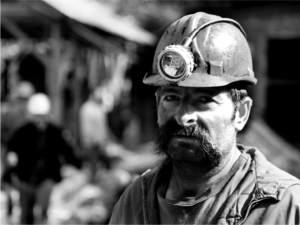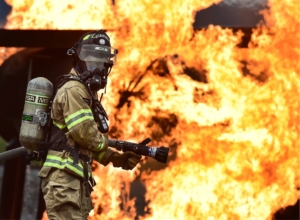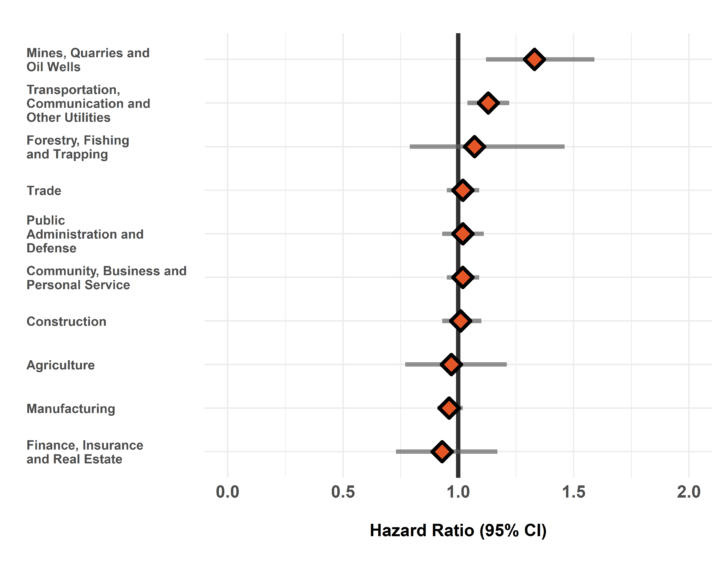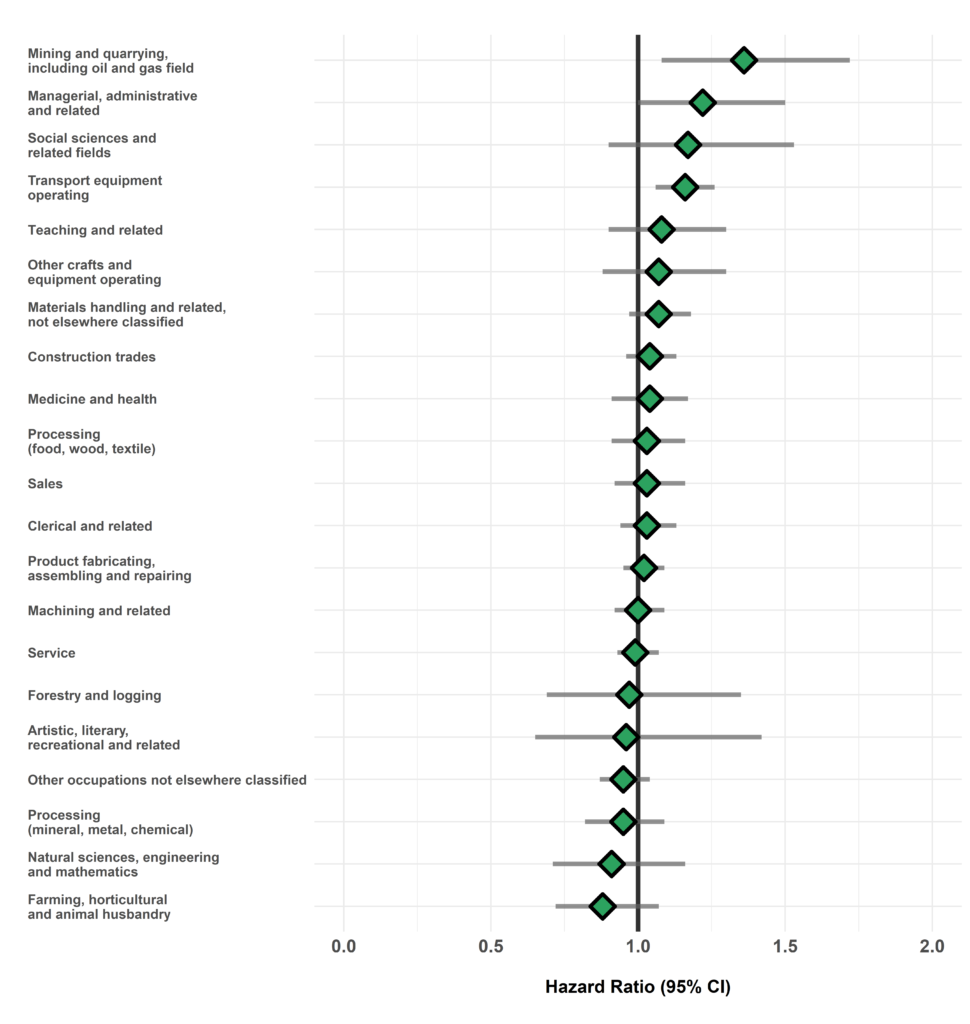Leukemia
Background
Leukemia is a cancer that originates in the blood stem cells. There are many different types of leukemia, grouped by where and how they develop. In adults, the most common leukemias are acute myeloid leukemia (AML) and chronic myeloid leukemia (CML) [1]. Occupational exposure to benzene is an established risk factor for AML and acute non-lymphocytic leukemia (ANLL), and there is some evidence it may increase the risk of other leukemias. Formaldehyde is an established risk factor for myeloid leukemia, and a suspected risk factor for other leukemias [2,3]. The International Agency for Research on Cancer (IARC) concluded that employment in rubber manufacturing was a leukemia risk factor, but suggested that the risk may be associated with exposure to solvents, particularly benzene [4].
Known occupational risk factors [2,5]
-
- Benzene
- Formaldehyde
- Ionizing radiation (X-radiation, gamma radiation)
Possible occupational risk factors [2,5,6]
-
- Petroleum refining
- Ethylene oxide
- Employment in the rubber production industry
- Metalworking fluids
Key Findings
These results are based on all leukemia types combined but occupational risk factors vary by leukemia type. In the ODSS, the greatest incidence of leukemia was observed for workers with exposure to benzene, including mining and transportation industry employees and firefighters.
Mining and quarrying

Increased leukemia risk among miners has been previously observed [7], and several studies have explored radon exposure as a possible risk factor, with inconsistent findings [8,9]. Uranium miners, who might be expected to have the greatest exposure to radon, showed an increased risk of leukemia compared to other workers in the ODSS, but the relative risk was lower than for miners in other mine types, so it is unlikely that this exposure is the driving risk factor. Uranium miners are also exposed to gamma radiation, which may be contributing to the observed risk. A previous study of Ontario uranium miners found no increased leukemia risk [10]. Thus, benzene may be a more significant risk factor for mining industry workers who can be exposed to benzene used in degreasing and use of gasoline-powered equipment, and combustion of petrochemical products.
-
- Mining and quarrying including oil and gas field, occupations: 1.36 times the risk
- Cutting, handling and loading occupations: 1.59 times the risk
- Other rock and soil-drilling occupations: 1.13 times the risk
- Mines (including milling), quarries and oil wells industries: 1.33 times the risk
- Non-metal mines: 1.78 times the risk
- Metal mines: 1.42 times the risk
- Miscellaneous metal mines: 1.53 times the risk
- Gold quartz mines: 1.35 times the risk
- Uranium mines: 1.27 times the risk
- Quarries and sand pits: 1.14 times the risk
- Mining and quarrying including oil and gas field, occupations: 1.36 times the risk
Transportation
Increased risks were observed among transportation industry workers, likely due to engine exhaust, which accounts for the largest source of benzene exposure in the general environment [11].
-
- Transportation industry: 1.10 times the risk
- Taxi cab operations: 1.40 times the risk
- Moving and storage, used goods, uncrated: 1.32 times the risk
- Other transportation: 1.21 times the risk
- Urban transit systems: 1.17 times the risk
- Other truck transport: 1.15 times the risk
- Bus transport, interurban and rural: 1.15 times the risk
- Transportation industry: 1.10 times the risk
Firefighters 
Firefighters are exposed to benzene and formaldehyde which are common in fire smoke, known leukemia risk factors [12,13], as well as many other chemicals. Increased leukemia risk has been previously reported among firefighters [14]. In Ontario, primary acute myeloid leukemia, chronic lymphocytic leukemia, and primary acute lymphocytic leukemia are classified as ‘prescribed diseases’, meaning that under certain conditions, these cancers are assumed to be work-related and are eligible for compensation [15].
-
- Firefighting occupations: 1.41 times the risk
Other groups
No excess risk of leukemia was observed among workers employed in rubber and plastics manufacturing industries, and too few cases were observed among workers in petroleum refineries to examine the association in that group. Excess risk observed among metal machining occupations and motor vehicle manufacturers may be linked to metalworking fluid exposure [16,17]. The risk among health workers could be linked to x-ray exposure, but too few cases were observed among radiological technicians to further explore this association. Acute myeloid leukemia has been previously reported among brick and stone masons [18]. Risk factors among other groups in the ODSS with excess risk remain unclear.
-
- Other occupations in medicine and health, not elsewhere classified: 2.56 times the risk
- Physiotherapists, occupational and other therapists: 2.52 times the risk
- Forming occupations: clay, glass and stone: 2.50 times the risk
- Brick and stone masons and tile setters: 1.45 times the risk
- Machinist and machine tool setting-up occupations: 1.34 times the risk
- Motor vehicle manufacturer industries: 1.32 times the risk
- Industrial farm machinery mechanics and repairers: 1.20 times the risk
Relative Risk by Industry and Occupation
Figure 1. Risk of leukemia diagnosis among workers employed in each industry group relative to all others, Occupational Disease Surveillance System (ODSS), 2006-2016

The hazard ratio is an estimate of the average time to diagnosis among workers in each industry/occupation group divided by that in all others during the study period. Hazard ratios above 1.00 indicate a greater risk of disease in a given group compared to all others. Estimates are adjusted for birth year and sex. The width of the 95% Confidence Interval (CI) is based on the number of cases in each group (more cases narrows the interval).
Figure 2. Risk of leukemia diagnosis among workers employed in each occupation group relative to all others, Occupational Disease Surveillance System (ODSS), 2006-2016

The hazard ratio is an estimate of the average time to diagnosis among workers in each industry/occupation group divided by that in all others during the study period. Hazard ratios above 1.00 indicate a greater risk of disease in a given group compared to all others. Estimates are adjusted for birth year and sex. The width of the 95% Confidence Interval (CI) is based on the number of cases in each group (more cases narrows the interval).
Table of Results
Table 1. Surveillance of Leukemia: Number of cases, workers employed, and hazard ratios in each industry (SIC)
| SIC Code * | Industry Group | Number of cases | Number of workers employed | Hazard Ratio (95% CI) † |
| 1 | Agriculture | 75 | 35012 | 0.97 (0.77-1.21) |
| 2/3 | Forestry, Fishing and Trapping |
40 | 10697 | 1.07 (0.79-1.46) |
| 4 | Mines, Quarries and Oil Wells |
131 | 23202 | 1.33 (1.12-1.59)** |
| 5 | Manufacturing | 2145 | 693548 | 0.96 (0.91-1.02) |
| 6 | Construction | 617 | 210961 | 1.01 (0.93-1.10) |
| 7 | Transportation, Communication and Other Utilities |
653 | 197190 | 1.13 (1.04-1.22)** |
| 8 | Trade | 992 | 429199 | 1.02 (0.95-1.09) |
| 9 | Finance, Insurance and Real Estate |
71 | 23983 | 0.93 (0.73-1.17) |
| 10 | Community, Business and Personal Service |
1340 | 599502 | 1.02 (0.95-1.09) |
| 11 | Public Administration and Defense |
592 | 190864 | 1.02 (0.93-1.11) |
| * SIC: Standard Industrial Classification (1970) | ||||
| † Hazard rate in each group relative to all others | ||||
Table 2. Surveillance of Leukemia: Number of cases, workers employed, and hazard ratios in each occupation (CCDO) group
| CCDO Code * | Occupation Group | Number of cases | Number of workers employed | Hazard Ratio (95% CI) † |
| 11 | Managerial, administrative and related |
93 | 30992 | 1.22 (1.00-1.50) |
| 21 | Natural sciences, engineering and mathematics |
65 | 26344 | 0.91 (0.71-1.16) |
| 23 | Social sciences and related fields |
57 | 30707 | 1.17 (0.90-1.53) |
| 25 | Religion | 0 | 128 | — |
| 27 | Teaching and related | 117 | 48473 | 1.08 (0.90-1.30) |
| 31 | Medicine and health | 289 | 135339 | 1.04 (0.91-1.17) |
| 33 | Artistic, literary, recreational and related |
25 | 14992 | 0.96 (0.65-1.42) |
| 41 | Clerical and related | 490 | 197316 | 1.03 (0.94-1.13) |
| 51 | Sales | 289 | 148093 | 1.03 (0.92-1.16) |
| 61 | Service | 919 | 919 (370824) | 0.99 (0.93-1.07) |
| 71 | Farming, horticultural and animal husbandry |
97 | 97 (50145) | 0.88 (0.72-1.07) |
| 73 | Fishing, hunting, trapping and related |
<5 | <5 (558) | — |
| 75 | Forestry and logging | 34 | 34 (10682) | 0.97 (0.69-1.35) |
| 77 | Mining and quarrying, including oil and gas field |
73 | 73 (13040) | 1.36 (1.08-1.72)** |
| 81 | Processing (mineral, metal, chemical) |
210 | 210 (79232) | 0.95 (0.82-1.09) |
| 82 | Processing (food, wood, textile) |
267 | 267 (99236) | 1.03 (0.91-1.16) |
| 83 | Machining and related | 605 | 605 (189404) | 1.00 (0.92-1.09) |
| 85 | Product fabricating, assembling and repairing |
1050 | 1050 (328296) | 1.02 (0.95-1.09) |
| 87 | Construction trades | 722 | 722 (215582) | 1.04 (0.96-1.13) |
| 91 | Transport equipment operating |
598 | 598 (168084) | 1.16 (1.06-1.26)*** |
| 93 | Materials handling and related, not elsewhere classified |
436 | 436 (153043) | 1.07 (0.97-1.18) |
| 95 | Other crafts and equipment operating |
99 | 99 (28300) | 1.07 (0.88-1.30) |
| 99 | Other occupations not elsewhere classified | 545 | 545 (215225) | 0.95 (0.87-1.04) |
| * CCDO: Canadian Classification Dictionary of Occupations (1971) | ||||
| † Hazard rate in each group relative to all others | ||||
Please note that ODSS results shown here may differ from those previously published or presented. This may occur due to changes in case definitions, methodological approaches, and the ongoing nature of the surveillance cohort.
References
- What is leukemia? – Canadian Cancer Society [Internet]. [cited 2020 Nov 5].
- IARC Working Group. List of Classifications by cancer sites with sufficient or limited evidence in humans, Volumes 1 to 113 [Internet]. Lyon, France: International Agency for Research on Cancer (IARC);
- Cancer Risk Factors in Ontario: Industrial Chemicals [Internet].
- IARC Working Group. A Review of Human Carcinogens- Chemical agents and related occupations [Internet]. Vol. 100F. Lyon, France: International Agency for Research on Cancer (IARC); 2012.
- Cogliano VJ, Baan R, Straif K, Grosse Y, Lauby-Secretan B, Ghissassi F El, et al. Preventable exposures associated with human cancers. J Natl Cancer Inst [Internet]. 2010;103(24):1827–39.
- Mirer FE. New evidence on the health hazards and control of metalworking fluids since completion of the OSHA advisory committee report. Am J Ind Med. 2010;53(8):792–801.
- Gilman P, Ames R, McCawley M. Leukemia risk among US white male coal miners: a case-control study. J Occup Environ Med [Internet]. 1985;27(9):669–71.
- Laurier D, Valenty M, Tirmarche M. Radon exposure and the risk of leukemia: A review of epidemiological studies. Health Phys [Internet]. 2001;81(3):272–88.
- Semenova Y, Pivina L, Zhunussov Y, Zhanaspayev M, Chirumbolo S, Muzdubayeva Z, et al. Radiation-related health hazards to uranium miners. Environ Sci Pollut Res [Internet]. Environmental Science and Pollution Research; 2020;27(28):34808–22.
- Navaranjan G, Berriault C, Do M, Villeneuve PJ, Demers PA. Cancer incidence and mortality from exposure to radon progeny among Ontario uranium miners. Occup Environ Med [Internet]. 2016;
- World Health Organization. Exposure to Benzene: A Major Public Health Concern. Geneva, Switzerland; 2010.
- CAREX Canada. Benzene – Occupational Exposures [Internet]. [cited 2020 Nov 5].
- Tsai RJ, Luckhaupt SE, Schumacher P, Cress RD, Deapen DM, Calvert GM. Risk of cancer among firefighters in California, 1988-2007. Am J Ind Med [Internet]. 2015;58(7):715–29.
- Soteriades ES, Kim J, Christophi CA, Kales SN. Cancer incidence and mortality in firefighters: A state-of-the-art review and meta-analysis. Asian Pacific J Cancer Prev [Internet]. 2019;20(11):3221–31.
- O. Reg. 253/07: FIREFIGHTERS under Workplace Safety and Insurance Act, 1997, S.O. 1997, c. 16, Sched. A [Internet]. 2018.
- García-Pérez J, López-Cima MF, Boldo E, Fernández-Navarro P, Aragonés N, Pollán M, et al. Leukemia-related mortality in towns lying in the vicinity of metal production and processing installations. Environ Int [Internet]. Elsevier Ltd; 2010;36(7):746–53.
- Costello S, Chen K, Picciotto S, Lutzker L, Eisen E. Metalworking fluids and cancer mortality in a us autoworker cohort (1941–2015). Scand J Work Environ Heal. 2020;46(5):525–32.
- Tsai RJ, Luckhaupt SE, Schumacher P, Cress RD, Deapen DM, Calvert GM. Acute myeloid leukemia risk by industry and occupation. Leuk Lymphoma [Internet]. 2014;55(11):2584–91. Available from: https://www.ncbi.nlm.nih.gov/pmc/articles/PMC4534715/
